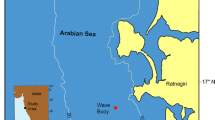Abstract
Significant wave height and zero-crossing wave period are used for validation of wave models, wave climate studies, and calculations of extremes for weather forecasting purposes. They represent also important parameters for design and operations of ships and offshore structures. They can be evaluated using 20 or 30-min long wave recordings directly or using the wave spectrum. Spectral methods often reduce the 20 min to about 17 min. Due to the limited duration of wave records, estimates of significant wave height and zero-crossing wave period are affected by sampling variability, the statistical uncertainty due to limited number of observations. The study provides estimates of sampling variability associated with significant wave height and zero-crossing wave period based on measurements from the Ekofisk field in central North Sea. Further, it demonstrates the impact of intrinsic and sampling variability has on short-term and long-term description of ocean waves as well as validation of wave spectral models.











Similar content being viewed by others
References
Bitner-Gregersen EM (2011) Reliability assessment of TLP air-gap in nonlinear waves. Proc. OMAE 2011 Conf., Rotherdam, The Netherlands, June 19–24, 2011
Bitner-Gregersen EM, Hagen Ø (1990) Uncertainties in data for the offshore environment. Struct Saf 7:11–34. doi:10.1016/0167-4730(90)90010-M
Bitner-Gregersen EM, Hagen Ø (2003) Effects of two-peak spectra on wave crest statistics. Proc OMAE 2003 Conf, Cancun
Bitner-Gregersen EM, Hagen Ø (2004) Freak waves in the second order wave model. OMAE’2004 Proc, Vancouver
Bitner-Gregersen E, Magnusson AK (2004) Extreme events in field data and in second order wave model. In proceedings of the rogue waves 2004 workshop, Ed. M. Olagnon and M. Prevosto, October 20–22, 2004, Brest, France
Bitner-Gregersen EM, Toffoli A (2009) Uncertainties of wind sea and swell prediction from the Torsethaugen model. Proc. OMAE 2009 Conf., May 31-June 5, 2009, Vol. 2, pp. 851–858, Honolulu, USA
Cartwright DE, Longuet-Higgins MS (1956) Statistical distribution of the maxima of a random function. Proc Roy Irish Acad 237:212–232
Donelan MA, Pierson WJ (1983) The sampling variability of estimates of spectra of wind generated gravity waves. J Geophys Res 88(C7):4381–4392
Forristall GZ (2000) Wave crest distributions: observations and second order theory. J Phys Oceanogr 30:1931–1943
Forristall G (2009) Offshore basin wave statistics. CresT Report. May 2009
Forristall GZ, Heideman JC, Leggett IM, Roskam B, Vanderschuren L (1996) Effect of sampling variability on hindcast and measured wave heights. J Waterway Port Coastal and Ocean Engineering 122:216–225
Hagen Ø (2007) Wave distributions and sampling variabitily. Proceedings of the 26th International Conference on Offshore Mechanics and Arctic Engineering (OMAE 2007), June 10-15, 2007, San Diego, CA, USA
Hjorteland K, Mes MJ, Magnusson AK (1999) Ekofisk observed weather compared with weather predictions. OTC 10768. Proc. Offshore Technology Conference in Houston, Texas, 3–6 May 1999
Krogstad HE (1982) On the covariance of the periodogram. J Time Ser Anal 3:195–207
Lipa BJ, Barrick DE, Maresca DE Jr (1981) HF radar measurements of long ocean waves. Practical methods for observing and forecasting ocean waves. J Geophys Res 86(C5):4089–4102
Longuet-Higgins MS (1952) On statistical distribution of the heights of sea waves. J Marine Res XI: (3)
Magnusson, A. K., 2011: “What is true sea state”. Proceedings, 11th international workshop on wave hindcasting and forecasting and coastal hazard symposium. JCOMM Technical Report 52, WMO/TD-No. 1533, IOC Workshop Report 232, Halifax, Canada October 18–23, 2009. (pdf: http://www.waveworkshop.org/11thWaves/Papers/WW11-AKM_metno.pdf)
Magnusson, A. K., and Donelan, M. A.: The Andrea wave. Characteristics of a measured North Sea rogue wave, JOMAE 2013
Monaldo F (1988) Expected differences between buoy and radar altimeter estimates of wind speed and significant wave height and their implications on buoy-altimeter comparisons. J Geophys Res 2285–2302
Olagnon, M, and Magnusson, A. K. 2004: Sensitivity study of sea state parameters in correlation to extreme wave occurrence. Proc. 14th Int. Offshore and Polar Engineering Conf., ISOPE 3, 2004.
Priestley MM (1981) Spectral analysis and time series. Academic, London
Reistad M, Breivik O, Haakenstad H, Aarnes OJ, Furevik BR, Bidlot J-R (2011) A high-resolution hindcast of wind and waves for the North Sea, the Norwegian Sea, and the Barents Sea. J Geophys Res. doi:10.1029/2010JC006402
Thorton EB, Guza RT (1983) Transformation of wave height distribution. J Geophys Res 88(C10):5925–5938
Toffoli A, Bitner-Gregersen EM (2011) Extreme and rogue waves in directional wave fields. Open Ocean Eng J 4:24–33. doi:10.2174/1874835X01104010024
Torsethaugen K (1996) Model for double peaked wave spectrum. SINTEF Civil and Environmental Engineering, Rep. No. STF22 A96204, Trondheim, Norway (1996)
Tucker MJ (1992) Recommended standard for wave data sampling and real-time processing. Tech. Rep. 3.14/186, E&P Forum, London, U.K., 25–28
Young IR (1986) Probability distribution of spectral integrals. J. Wirwy., ports, Coast., and Oc. Engrg. ASCE 112(4):338–341
Acknowledgments
This work has been supported by the Norwegian Research Council project ExWaCli (Project No. 226239) and the EU project EXTREME SEAS (SCP8-GA-2009-234175). The authors are indebted to MET Norway and ConocoPhillips for providing the wave data.
Author information
Authors and Affiliations
Corresponding author
Additional information
Responsible Editor: Alexander V. Babanin
This article is part of the Topical Collection on the 13th International Workshop on Wave Hindcasting and Forecasting in Banff, Alberta, Canada, October 27 - November 1, 2013
Appendix A—sampling variability
Appendix A—sampling variability
Tables and include sampling variability standard deviations of the significant wave height and zero-crossing wave period, respectively, for the Northern North Sea scatter diagram calculated by Bitner-Gregersen and Hagen (1990). Assuming Gaussian sea surface and the JONSWAP spectrum with γ = 3.3. The results are valid for any worldwide location under the adopted assumptions.
Rights and permissions
About this article
Cite this article
Bitner-Gregersen, E.M., Magnusson, A.K. Effect of intrinsic and sampling variability on wave parameters and wave statistics. Ocean Dynamics 64, 1643–1655 (2014). https://doi.org/10.1007/s10236-014-0768-8
Received:
Accepted:
Published:
Issue Date:
DOI: https://doi.org/10.1007/s10236-014-0768-8




